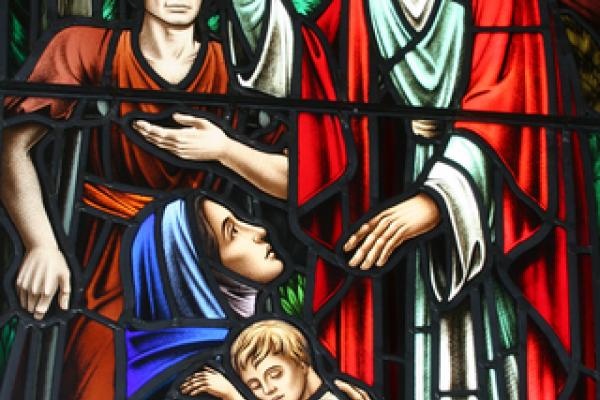I've been thinking, as Advent goes on, what it meant for God to lay aside infinity and put on a body that was not just tiny, inarticulate, and helpless, but also already marked, to the marrow of its little bones, with the seeds of death.
He must have felt in his own flesh this dramatic comedown — from omnipotence and omnipresence to a being that had about threescore and 10, max, even if it hadn’t going to be cut off halfway by self-sacrifice and Roman capital punishment. And that must have given Jesus infinite tenderness and patience towards the waves and waves of people who, during his short ministry, were always coming up to him and asking, directly or just by their presence, for him to heal their bodies. In Luke, the Gospel focus of the new liturgical year, there are more than 20 healings by my count, compared to two times when someone asks Christ how to get eternal life (and only one of them actually wanted to know).
Those healings of all those bodies matter, millennia later. One big reason they matter is because healing matters. Another is because, by showing God's power over death as well as by going through death ahead of us, Christ teaches us not to be dominated by fear of it.
All this is very personal for me. Nearly seven years ago, in April 2006, doctors gave me super-intense chemotherapy to cure my Hodgkin's lymphoma. To help me survive the process, first they froze some of my stem cells (essentially, bone marrow, except that they filtered them out of my blood — actually drilling into bones is so 1990). Then, after the chemo and three days after Easter, they re-infused those cells back into my body to restart my bone marrow. I remember watching the tiny pink bag dripping through the IV, through which the seeds of survival would swim back into my veins, and then into my bones. Day by day, those cells moved invisibly inside my body, to grow and thrive.
Thanks be to God and to a lot of great nurses and doctors, they did cure my lymphoma. But now, as a late-breaking side effect, I have a different kind of cancer. (Yes, this sucks, but I'm still better off than if I'd died of the original cancer several years ago). So now, if all goes well, next year I might be spending another Easter in the hospital getting my own personal immunological rebirth. This time the point is to give me stem cells from a relative — cells that, Lord willing, will have an immune response that kills my cancer.
In my case, I have two siblings and a parent who are close enough to be stem cell donors — but there are many people in my shoes who don't. That's why, this Advent, I encourage everyone between the ages of 18 and 44 to consider joining the national bone marrow donor registry. It only takes an online survey and mail-in cheek swab to join. (Notwithstanding the name, in the unlikely event you're matched and get the opportunity to donate, there's usually no bone-drilling or anesthesia — just a series of shots to make your marrow overproduce into your blood, and then sitting next to a machine for a few hours while it filters out those lifesaving extra cells. I did this for myself back in 2006, and my main symptom was boredom).
Photo: Jesus healing, © V. J. Matthew | View Portfolio / Shutterstock.com
As we prepare to celebrate God's arrival in human flesh, as we start the liturgical year's journey through a ministry in which Christ heals people's bodies as well as their souls, there's no better time to sign up to offer others the gift of life.
Elizabeth Palmberg is an associate editor of Sojourners magazine. She blogs about surviving cancer at www.cherisheach.com.
Got something to say about what you're reading? We value your feedback!
